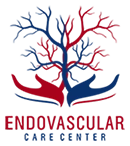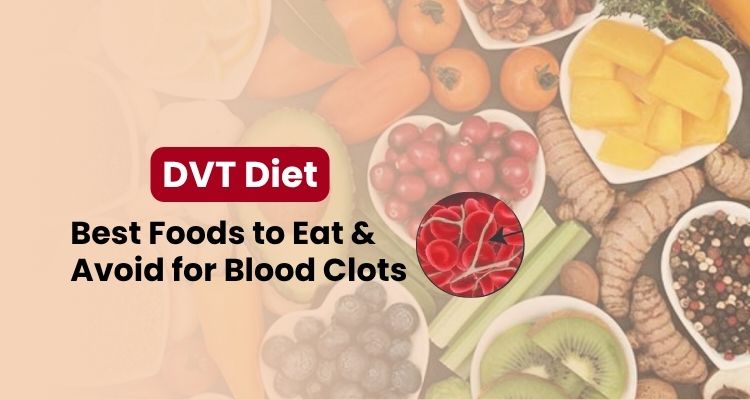A balanced diet is the basis for treating serious conditions like Deep Vein Thrombosis (DVT). Because what you consume affects your blood circulation directly. If you notice early signs of DVT and start an appropriate diet, you may improve circulation in your blood and make your veins stronger, protecting your entire vascular system.
The right food habits that you adopt are a strong move towards getting rid of DVT symptoms. It is therefore necessary to understand what to eat when you have DVT and plan your diet chart accordingly. Let’s see what foods to consume, what to avoid, and how to avoid blood clots as far as possible.
Foods to Eat for DVT
A balanced diet aids in proper blood flow and reduces the risk of deep vein thrombosis. The right foods to eat for DVT can assist your veins in working efficiently and keeping the cardiovascular system in good condition.
- Drink Enough Water
Keeping your body hydrated supports smooth blood flow and proper blood consistency. Lack of fluids can thicken blood and slow circulation, raising the risk of DVT, particularly during extended periods of inactivity.
- Eat Plenty of Fruits and Vegetables
A variety of fruits and vegetables, including leafy greens, support cardiovascular health. Some have mild antiplatelet effects, serving as blood thinner food. Though they cannot replace prescribed medications, you can expect improved healthy circulation.
- Go for Lean Meats
Without a doubt, protein is a must in one’s diet, but at the same time, fatty meats like pork and beef have the potential to elevate your cholesterol levels. Opt for lean meat such as chicken or fish that will not only be a beneficial diet for deep vein thrombosis but will also be a good cardioprotective agent without any additional fat.
- Use Olive Oil
Phenol-rich healthy fats in olive oil may reduce platelet activity and, hence, the chance of clotting will be less. Besides, olive oil is the major one among blood thinning foods that keep the heart healthy and the body in good condition.
- Add Whole Grains
Whole grains are full of fibre, protein, antioxidants, and minerals. Including them in the diet on a regular basis will maintain a healthy body weight and heart function, and thus, whole grains will be the best diet for blood clots.
Food to Be Avoided for DVT
Certain foods can lead to an increase in clot formation. So a patient suffering from DVT should not overly consume these types of foods. Understanding what foods to avoid in DVT will help the blood to flow better and the heart will be healthier.
- Trans Fats and Saturated Fats
Fried foods, baked goods and processed foods all can raise cholesterol levels and slow down blood circulation. Harmful fats can raise your risk for clotting and should be particularly avoided.
- Sugary Foods
Carbonated drinks, candies, and desserts are the main causes of inflammatory processes, and they also disturb the normal blood flow. Moreover, too much sugar can lead to serious complications of the cardiovascular system, as well as cause increased clotting.
- Salty Foods
Overeating salt brings about water retention in the body, and, therefore, blood pressure rises. High blood pressure usually results in the extra work being done by the veins and, consequently, the probability of clotting increases over a longer period of time.
- Red Meat
Fatty and processed red meat is loaded with saturated fat that takes a toll on heart health. So red meat is one of the blood clotting foods to avoid. Lean protein options will keep cholesterol levels moderate and circulation normal.
- Alcohol
Alcoholic beverages like beer can cause dehydration. This makes the blood thicker and more prone to clotting. Keeping hydrated and following the diet for DVT patient are good ways of reducing these risks.
- Excess Vitamin K-Rich Foods
Leafy greens such as spinach, kale and broccoli have vitamin K that impacts blood-thinning medications. Eating these vegetables in moderation, under medical guidance ensures safe intake while still benefiting from foods that prevent blood clots.
Foods to Eat to Prevent DVT
A proper diet for deep vein thrombosis supports healthy circulation in the legs and veins while reducing the risk of clot formation. Including these foods regularly protect vascular health and improves overall blood flow throughout the body.
- Omega-3 Foods
Fish varieties such as salmon, sardines, and mackerel contain a lot of omega-3 fatty acids. These good fats prevent DVT and encourage healthier heart and vascular function.
- Green Leafy Vegetables
Consuming spinach, kale or any of the most common leafy greens helps keep blood flowing freely and reduces inflammation. This supports healthier veins and arteries, improving overall vascular function.
- Citrus Fruits
Oranges, lemons, and similar fruits are packed with vitamin C. It is the main factor responsible for the tightening of blood vessel walls as well as the reduction of clotting, while at the same time it facilitates smoother blood flow. Hence, it makes these fruits very essential to a DVT nutrition plan.
- Nuts and Seeds
Walnuts, almonds, and flaxseed have antioxidants and healthful fats that power blood flow and potentially support general cardiovascular health.
- Garlic and Ginger
Garlic and ginger are two natural agents that prevent blood from thickening. Regular intake of these two may lower the risk of occlusion of the blood vessels.
- Whole Grains
Brown rice and whole wheat bread improve heart health. The fibre in them promotes consistent circulation and lowers the possibility of clot development. This makes these whole grains one of the best food for blood clot prevention.
- Water and Hydrating Foods
Water keeps your blood flowing smoothly, and it does not let your blood become thick. Proper drinking of water and water containing fruits like cucumber and watermelon will lower the chances of clots.
Understanding When to Consult a Doctor
Prevention reduces DVT risk but can’t eliminate it entirely. Even if you live a healthy life, the risk of a clot is still there. Knowing what DVT food restrictions are and the right time to call a doctor is equally important.
If you have any of the following symptoms, you should see a doctor immediately and without any hesitation.
- Swelling of one leg, which cannot be explained at all, and very rarely, swelling of both legs
- Abnormal pain, tenderness, or a sense of heaviness in the leg that continues for a long time
- Redness, colour change, or warmth in the involved area
Effective DVT treatment in Mumbai includes options such as blood thinners for small clots and surgical procedures for larger or dangerous clots to prevent complications.
Quick medical intervention keeps the condition from getting severe and supports the general health of the blood vessels. Prompt diagnosis, the right treatment and following a proper diet after DVT diagnosis are still the best means of taking control of deep vein thrombosis.
Conslusion
A diet suitable for a DVT promotes good circulation, and blood vessels become strong. However, a detailed medical check-up is still necessary for the right treatment. It is possible to prevent miserable scenarios by recognising what DVT is and consulting a doctor promptly.
Dr. Kunal Arora, a top Interventional Radiologist in Mumbai, has lots of experience in using modern and less invasive methods to treat deep vein thrombosis. Besides accurate diagnosis and efficient treatment, he also gives guidance about a suitable diet for DVT that nourishes the circulation, makes the veins strong and lessens the chances of getting clots again.
Don’t let your veins suffer any longer. Make an appointment with Dr. Kunal Arora to get the best treatment for DVT, along with individual dietary recommendations for a quicker recovery and sustaining the health of your veins.


